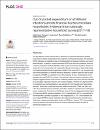Out-of-pocket expenditure on childhood infections and its financial burden on Indian households: Evidence from nationally representative household survey (2017–18)
| Author | Farooqui, Habib Hasan |
| Author | Karan, Anup |
| Author | Mathur, Manu Raj |
| Author | Hussain, Suhaib |
| Author | Selvaraj, Sakthivel |
| Available date | 2023-02-26T06:03:50Z |
| Publication Date | 2022-12-01 |
| Publication Name | PLoS ONE |
| Identifier | http://dx.doi.org/10.1371/journal.pone.0278025 |
| Citation | Farooqui HH, Karan A, Mathur MR, Hussain S, Selvaraj S. Out-of-pocket expenditure on childhood infections and its financial burden on Indian households: Evidence from nationally representative household survey (2017-18). PLoS One. 2022 Dec 27;17(12):e0278025. doi: 10.1371/journal.pone.0278025. |
| Abstract | The key objective of this research was to estimate out of pocket expenditure (OOPE) incurred by the Indian households for the treatment of childhood infections. We estimated OOPE estimates on outpatient care and hospitalization by disease conditions and type of health facilities. In addition, we also estimated OOPE as a share of households’ total consumption expenditure (TCE) by MPCE quintile groups to assess the quantum of the financial burden on the households. We analyzed the Social Consumption: Health (SCH) data from National Sample Survey Organization (NSSO) 75th round (2017–18). Outcome indicators were prevalence of selected infectious diseases in children aged less than 5 years, per episode of OOPE on outpatient care in the preceding 15 days, hospitalization in the preceding year and OOPE as a share of households’ total consumption expenditure. Our analysis suggests that the most common childhood infection was ‘fever with rash’ followed by ‘acute upper respiratory infection’ and ‘acute meningitis’. However, the highest OOPE for outpatient care and hospitalization was reported for ‘viral hepatitis’ and ‘tuberculosis’ episodes. Among the households reporting childhood infections, OOPE was 4.8% and 6.7% of households’ total consumption expenditure (TCE) for outpatient care and hospitalization, respectively. Furthermore, OOPE as a share of TCE was disproportionately higher for the poorest MPCE quintiles (outpatient, 7.9%; hospitalization, 8.2%) in comparison to the richest MPCE quintiles (outpatient, 4.8%; hospitalization, 6.7%). This treatment and care-related OOPE has equity implications for Indian households as the poorest households bear a disproportionately higher burden of OOPE as a share of TCE. Ensuring financial risk protection and universal access to care for childhood illnesses is critical to addressing inequity in care. |
| Language | en |
| Publisher | Public Library of Science |
| Subject | childhood infections Out-of-pocket expenditure Indian households financial burden |
| Type | Article |
| Issue Number | 12 December |
| Volume Number | 17 |
| ESSN | 1932-6203 |
Files in this item
This item appears in the following Collection(s)
-
Medicine Research [1337 items ]


